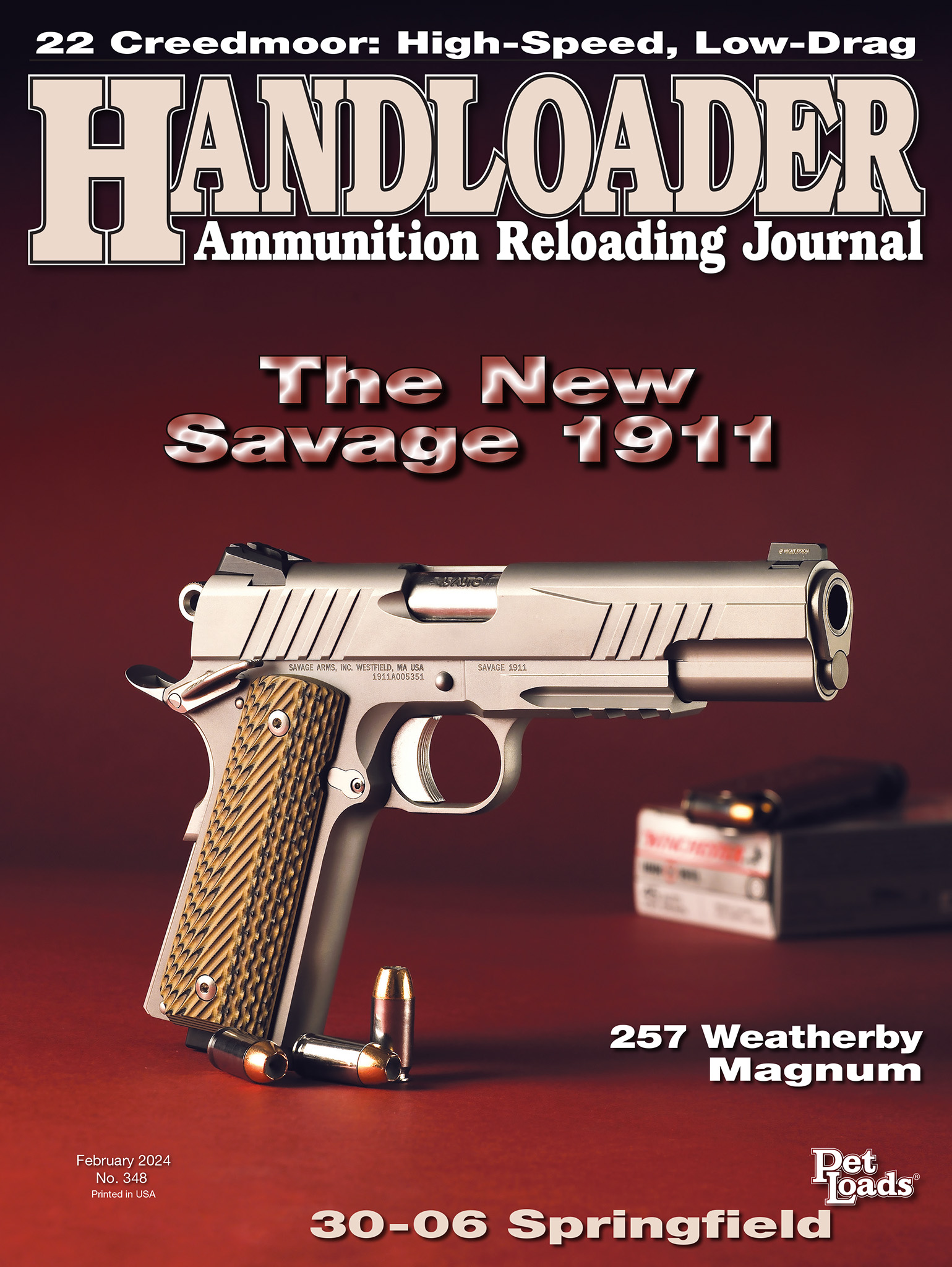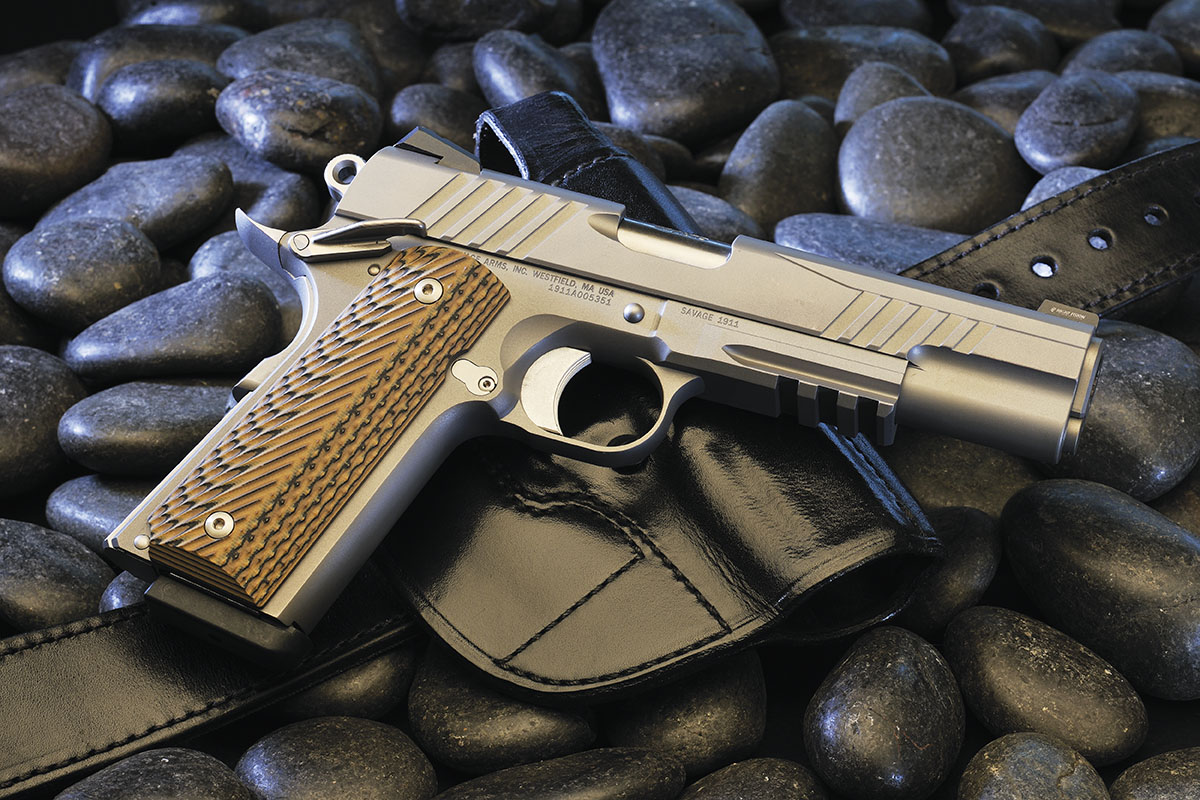
The new Savage Model 1911 45 ACP in stainless steel.
I can hear the cries now… “Not another Model 1911 handgun joining the ranks of the dozens on the market now”… they say. All of you are probably right, as there are plenty of Model 1911 variants in production now and the question does come up. Do we really need another one? To that, I have to answer yes, especially when the new one from Savage was designed from the ground up, has an affordable price point and is available in a variety of models and two calibers.
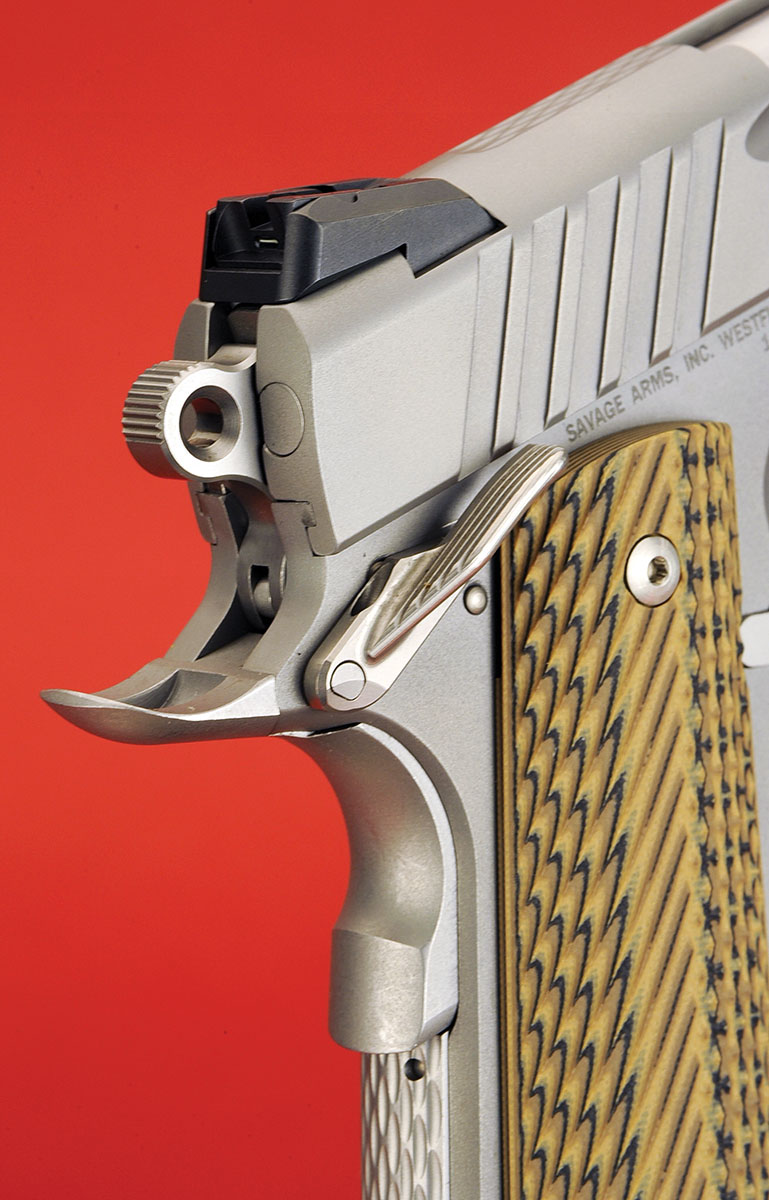
Details abound with this gun. Note the beavertail safety, right-side safety lock, low-profile sights and the Commander-styled hammer.
However, let’s regress a bit to a time around 1906 when the name Savage appeared in a contest with Colt and a few others led by the Department of Ordnance looking for a .45-caliber handgun for use primarily by the cavalry and the artillery branches of the army. While the details of the testing are far too involved to record here, needless to say, after thousands of rounds, testing and evaluations, the Colt variant won the prize, which puts us into the world of the Model 1911, which so many of us favor today.
No doubt, this new Savage is one of the most up-to-date semiautomatic pistols currently available to purchase. In the overall design, materials and functioning of the gun, this gun is certainly in line to be one popular gun for the 1911 enthusiast. Starting out, this gun is made to go the distance with a forged stainless steel slide and frame. Checking in at just under 3 pounds unloaded, this gun, like others in its ilk, has a distinctive presence in the hand. No matter what Model 1911 I picked up, they all felt the same to a point. On the Savage, to me, it’s a combination of weight, smaller features like the smooth front or the scalloped rear of the pistol grip and the aggressive grip panels on this popular shooting platform.
With a pistol being around for decades with variations counting into the dozens, sometimes it’s hard to improve upon a good thing. In years past, most were happy just to get a factory Model 1911 from…only for a short time I might add…from Colt. I had the hots for a gun in 38 Super and found one from Colt, but at the time, it only came with rudimentary fixed sights. Using it in competition, I found a gunsmith in nearby New York state and had the trigger worked on, an arched housing installed and of course, those in demand Bo-Mar Deluxe sights machined into the slide.
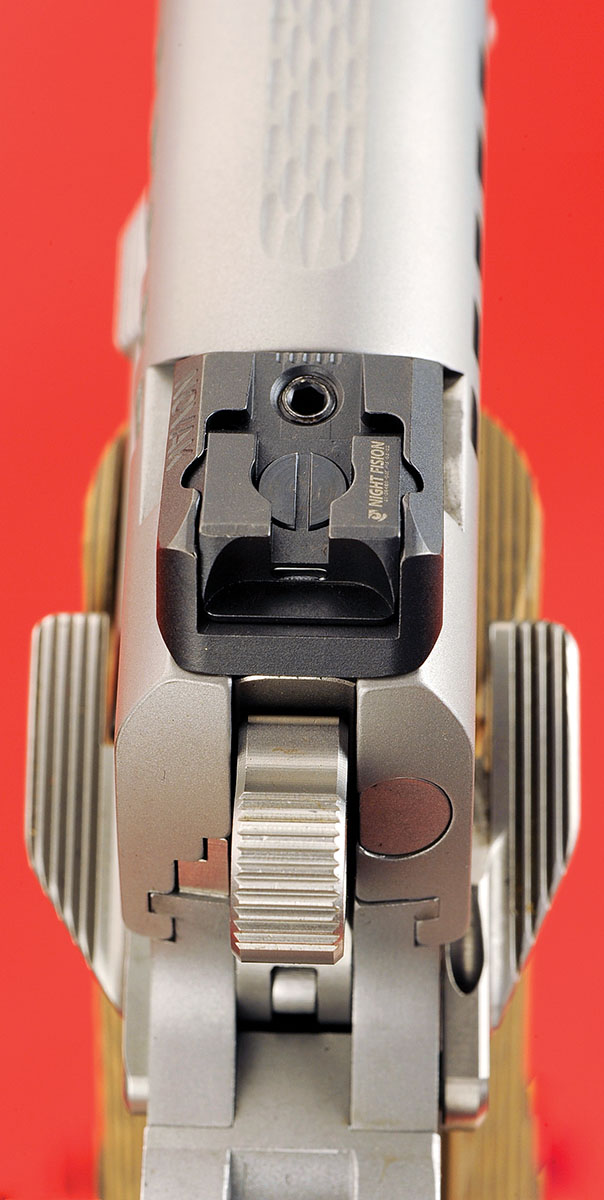
High and to the rear, the Novak sights are pinned into the slide but are fully adjustable for windage and elevation. Ambidextrous safety levers are shown here.
In the same time period, companies like Shockey or Pachmayr, or men like Jimmy Clark, were turning out “custom” pistols with most of the features we see on the pistols today as standard equipment. Aside from this, the machining of slides to make them fit better on the frame, refining trigger pulls and various finishes all helped to propel the 45 ACP into the popularity range it enjoys today.
With that in mind, Savage has joined this elite group of manufacturers turning out guns next to custom, but retaining acceptable price points of under $1,500, no matter the model or options. On top of all this, Savage entered the market with gusto with a line of sixguns to include finishes of black nitride, stainless and two-tone all with a choice of the 45 ACP or the 9mm Luger.
My sample came in stainless and I could not have been more pleased. The lines were true and the finish was a subdued or matte that was smooth to the touch. While the gun is the same platform we’ve seen for years, Savage took the approach to make the gun just a little bit different in a number of areas.
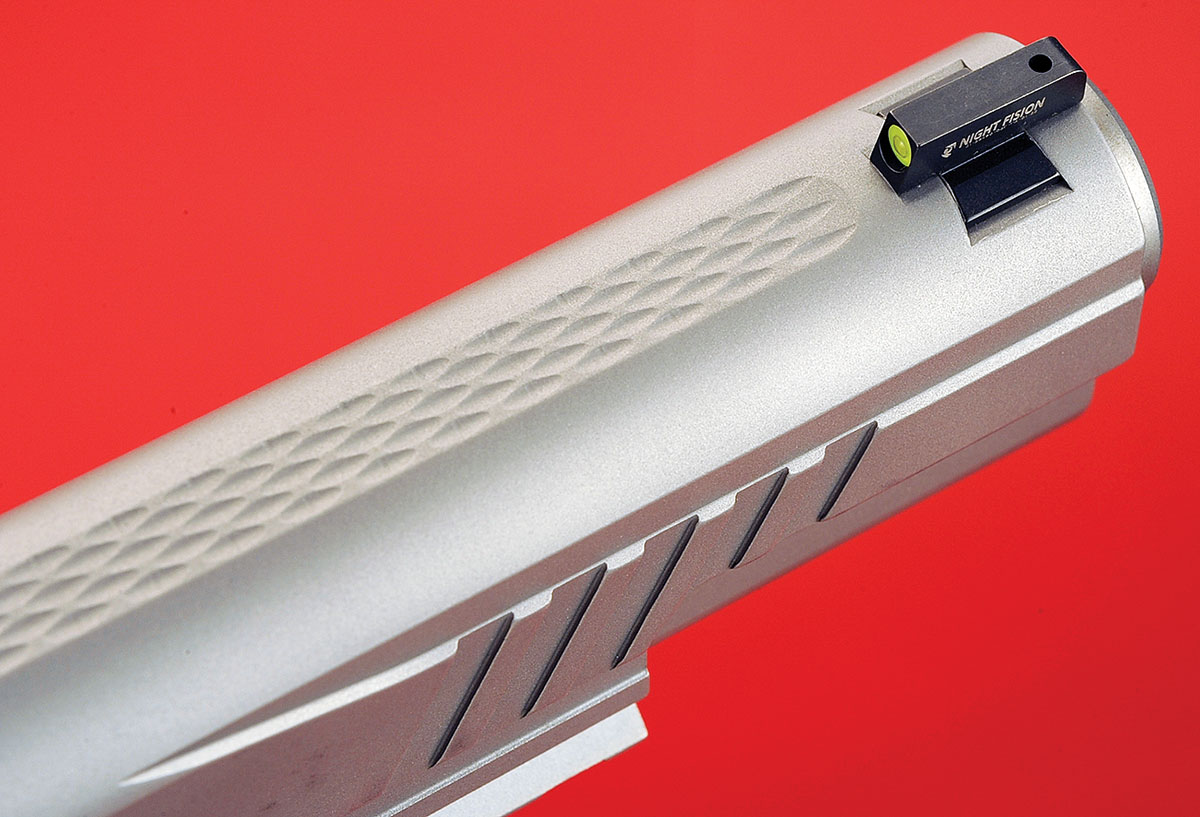
On the top side of the slide, a different approach has been applied to the “rib” in the form of a chain-like pattern. The front sight is a Mega Dot Dome-type fixture.
Cocking serrations are normal these days on the front and rear located on each side of the slide. Details of the Novak rear sight include the ability to adjust it for both windage and elevation. While this sight is pressed in place, it is also pinned to the dovetail with a setscrew. The notch is well defined and when shooting, the Mega Dot front night sight fits comfortably into the notch with just a bit of daylight on each side confirming your target.
Making the slide stand out are stepped cuts running from the muzzle end back and upward towards the ejection port. On the top of the slide is a distinctive rib that looks like a chain-like pattern to cut reflections and when it comes to the ejection port, it was designed and executed to be lower, flared and cut out to facilitate live-round ejection. Both the ejector and extractor are located inboard on the slide and frame. The stainless barrel is 5 inches long, machined from a solid billet complete with an 11-degree target crown and a dual recoil spring system. Inside, you will find a nitride-coated titanium firing pin in concert with a tool steel sear and disconnector.
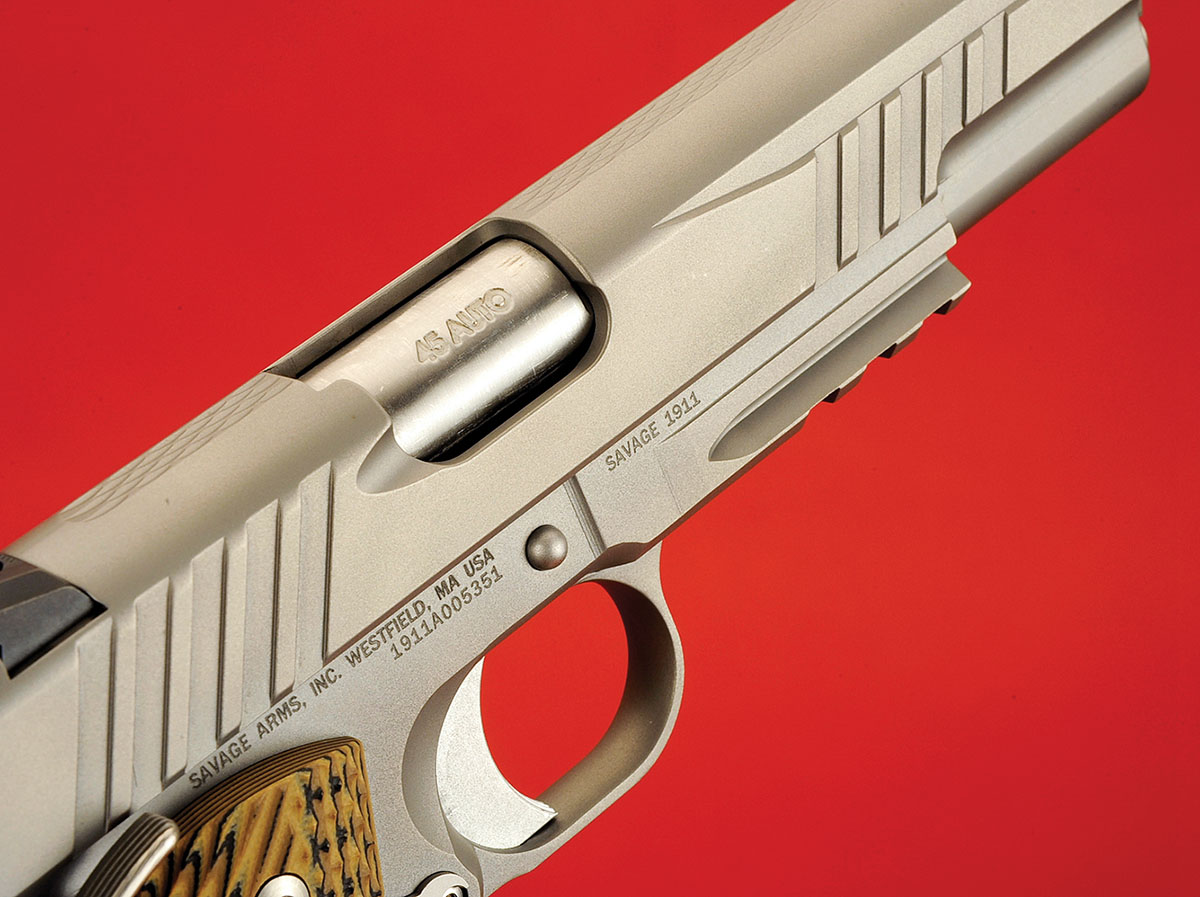
In this side view, see how the Picatinny mount fits seamlessly into the frame. The ejection port is machined into the slide to allow live factory ammunition to be cleared easily and has been lowered and flared for ejection.
Moving back and off the slide, the stainless steel hammer is patterned after the now-popular Commander profile with the usual half cock position. When the gun is cocked, it sits into the well on the beavertail safety to allow full functioning of the gun. I found this safety comfortable to hold and shoot, including the beefed-out section at the bottom serving as a memory bump. Below that is the straight mainspring housing, again complete with the chain design.
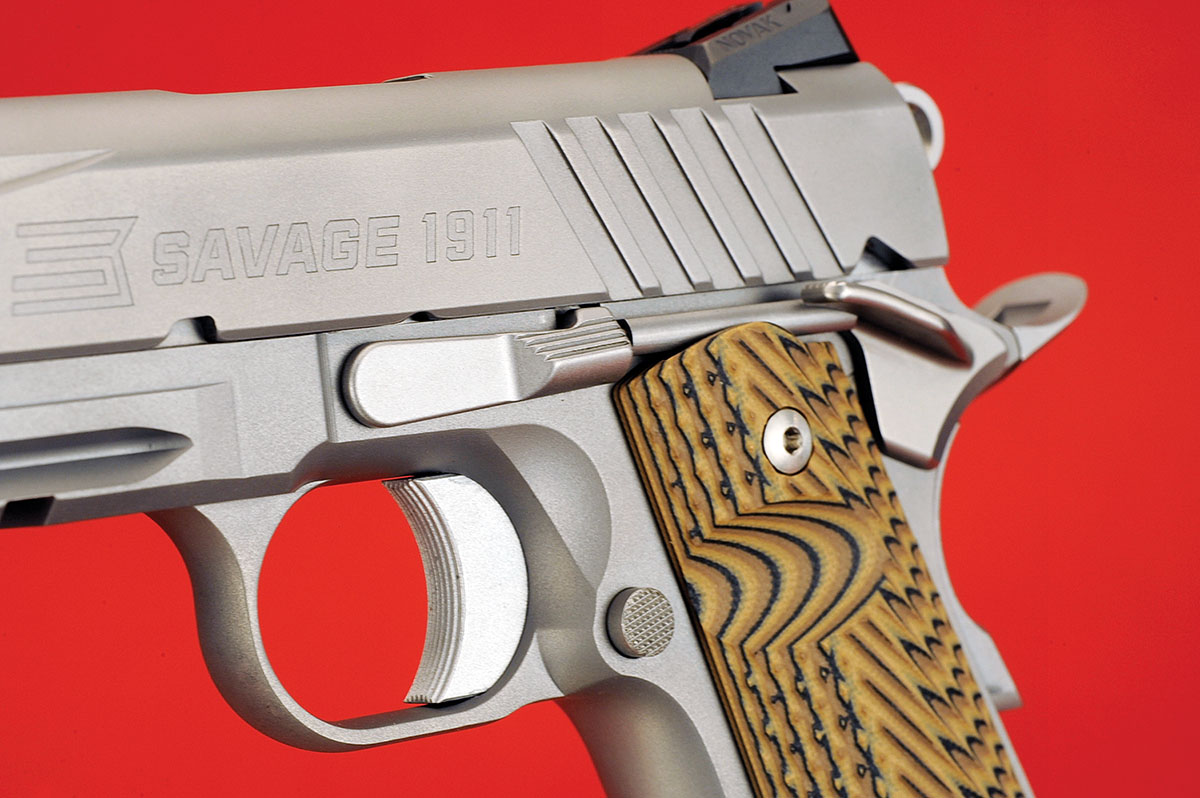
Typical of any Model 1911, the shooter controls shown here are the slide stop, safety lever, solid trigger and the relief of the grip for the magazine release.
The grip frame has many features now standard on higher-end handguns. The grips are from VZ Grips and are not only handsome in color and figure but have just enough texture to hold the gun firmly during shooting. They are relived longer and wider for the magazine release located behind the trigger. Below the front of the grip frame is smooth and could use checkering or stippling, but again, it is something extra that could relate to the original (read higher) cost of the pistol during its initial launch.
The single-action trigger is solid, serrated and after a good session at the range, it broke at 5 pounds plus a few ounces with just a bit of take-up. Above that is the slide release, further back you will find ambidextrous safety levers. Forward of the trigger guard, the Picatinny mount is machined in as an option on all models, which simply means you can have it your way – with or without this mount. With the mount, you may need a new holster, so factor that into the purchase. The gun comes with a slightly beveled magazine well and two magazines.
Chambered for the 45 ACP range time was shared with handloads and factory loads with the gun secured in a Ransom Rest. This would allow the gun to be on its own when it came to accuracy testing – not hindered by the hands of a human – to bring out the best in any gun. The handloads consisted of common, everyday components in bullets, powders, primers and fresh 45 cases with CCI No. 300 Large Pistol primers.
Being around for more than a century now, the 45 ACP has had plenty of time to evolve to near perfection in both factory ammunition and handloading duties for target, defense and law enforcement. Right now, there are plenty of companies producing many thousands of 45 ACP cartridges, with many bullet styles and velocities for all. From wadcutters to high-velocity defensive rounds, one only has to visit his nearest gun store to take note of the variety available.
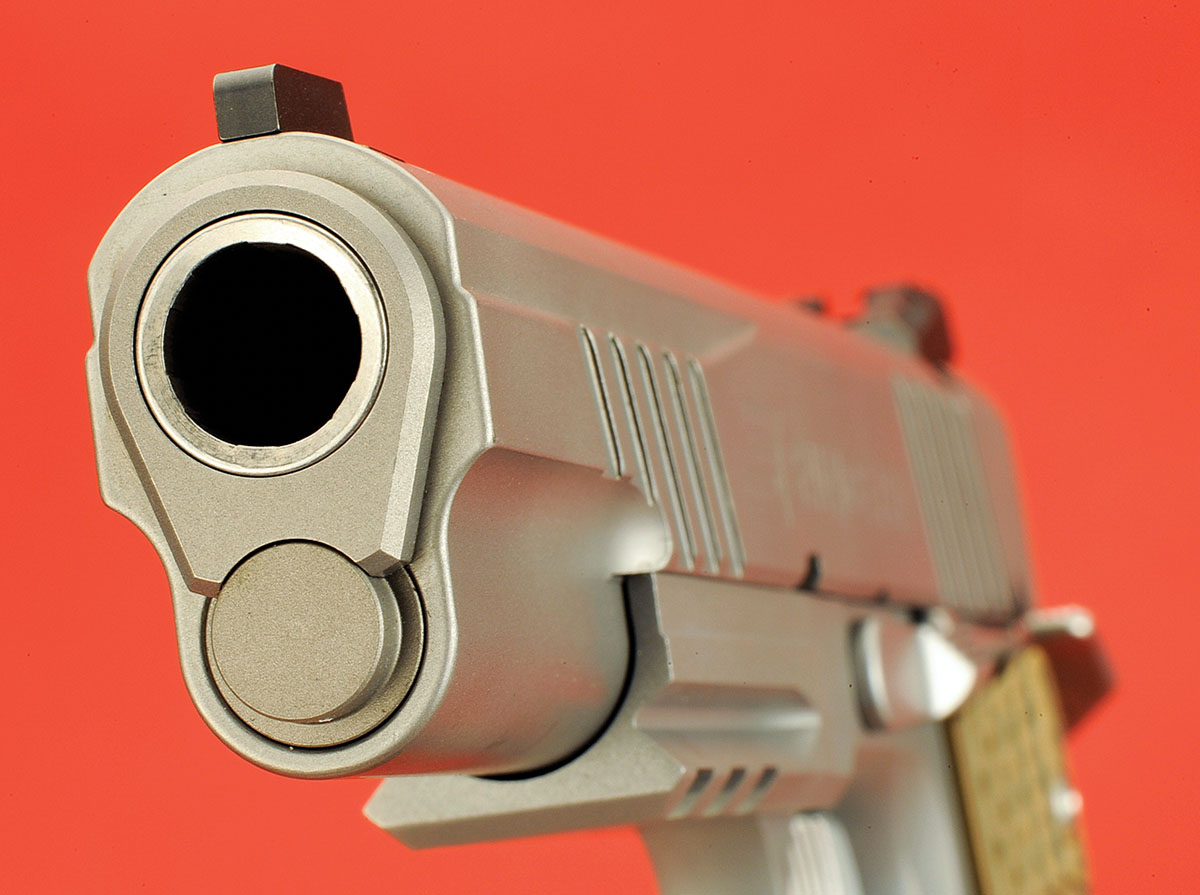
The muzzle end of the gun shows the detailing of the 11-degree target-styled crown and close tolerances of the barrel to the barrel bushing.
That said, handloading is next in line for those looking for or needing specialized ammunition. Looking back some 45 years ago when I was involved in the IPSC matches, I purchased a Colt Gold Cup, and had it hard chromed by Devel to keep the holster wear down. With 6 grains of Unique, I collected a fair amount of the prizes. I still have that gun, still accurate and still running smooth.
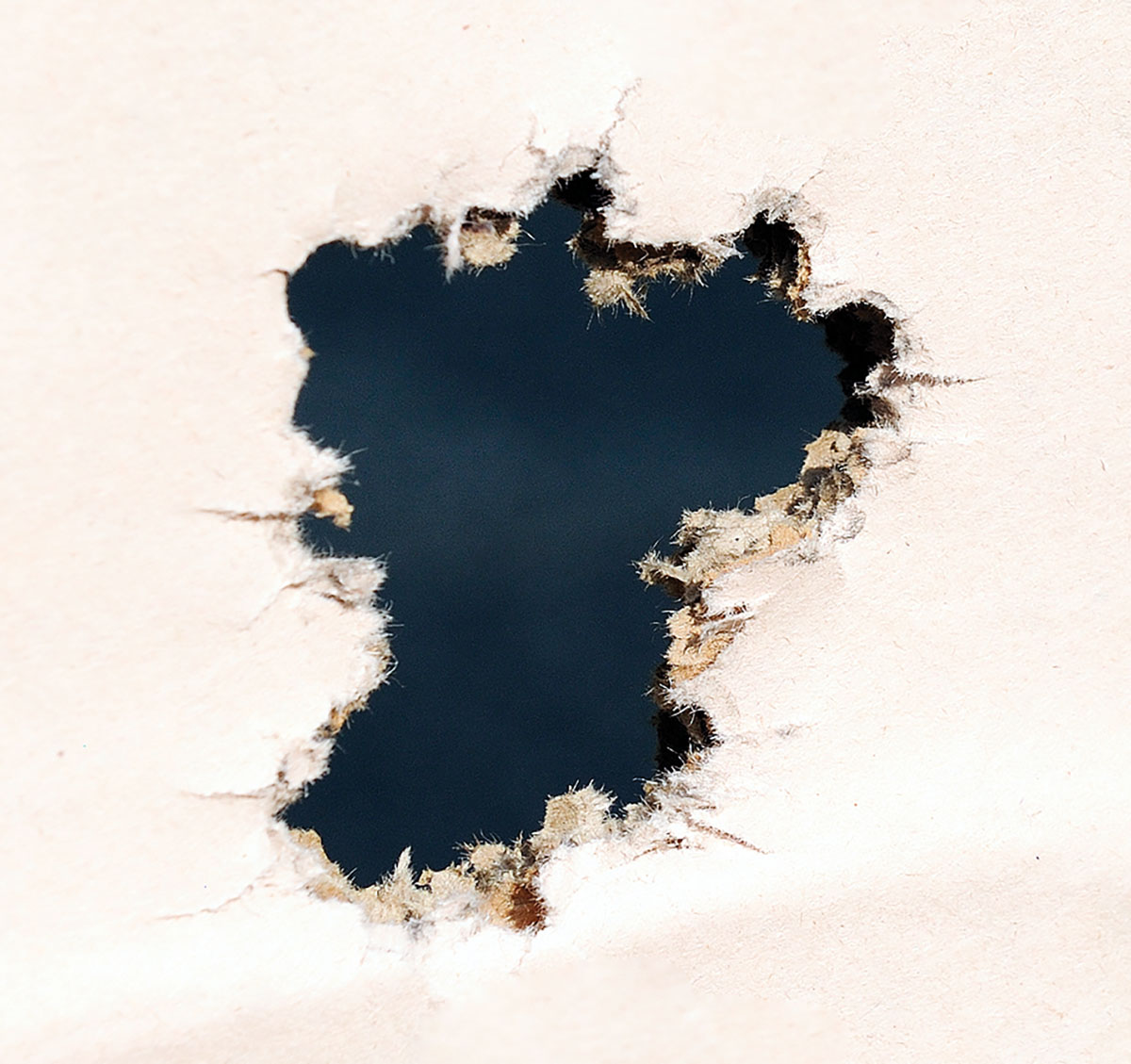
This group measures roughly 2 by 2 inches and included more than 60 rounds from the rest, plus the sighting-in shots with the Savage Model 1911.
When it came to the Savage, I started out with bullets in the 185-grain range, and then moved up to 200 and 230 hardball from Remington, Speer, Hornady, SIG Sauer and Sierra. While I was looking for decent velocities from all, I did not want to batter the shooter or the gun to pieces with hot loads. No need to.
Powders are easy to come by, as they seem to be the most popular even today in the .45 caliber. Look no further than the likes of Unique, Accurate No. 5 or W-231, as they will fill cases with aplomb. They are in the faster-burning category and economical to the tune of getting almost 1,200 loads per pound when using a 6-grain charge per case; which at today’s prices comes to around three cents per round for propellant.
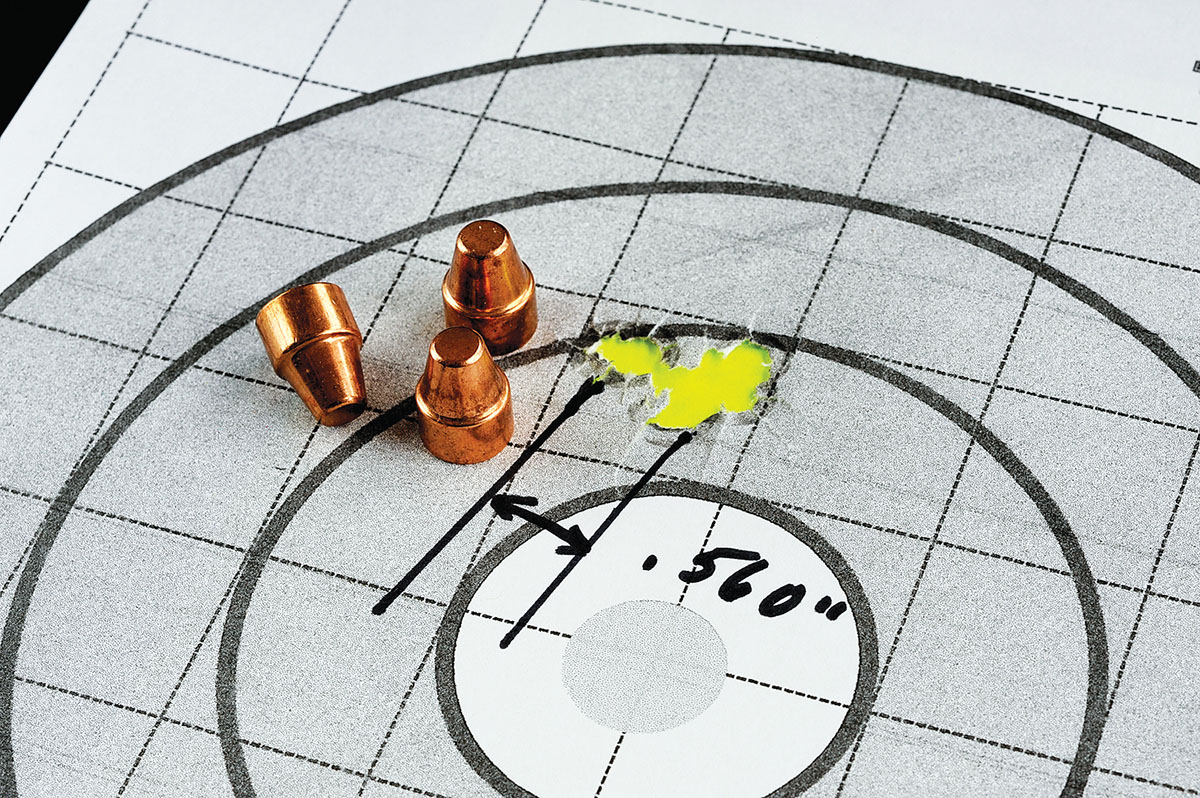
The best group of the day was a very tight five-shot example that came in at .560 of an inch. All groups were fired from the rest at 20 yards.
Ditto on cases and die sets. Factory freshness might be a problem in some areas because of the supply chain, but they are there from Hornady or Starline. When it comes to once-fired cases, I used to see pails of them but that too has dwindled a bit but they still are there in some gun shops. Die sets from mild to wild from RCBS, Hornady, Lyman or Redding with special inserts to match the contour of the bullet rate high on my list as well as tungsten carbide – no lubing necessary. In addition, there are such goodies as a special expander die or “premium” seating dies with a micrometer adjustment.
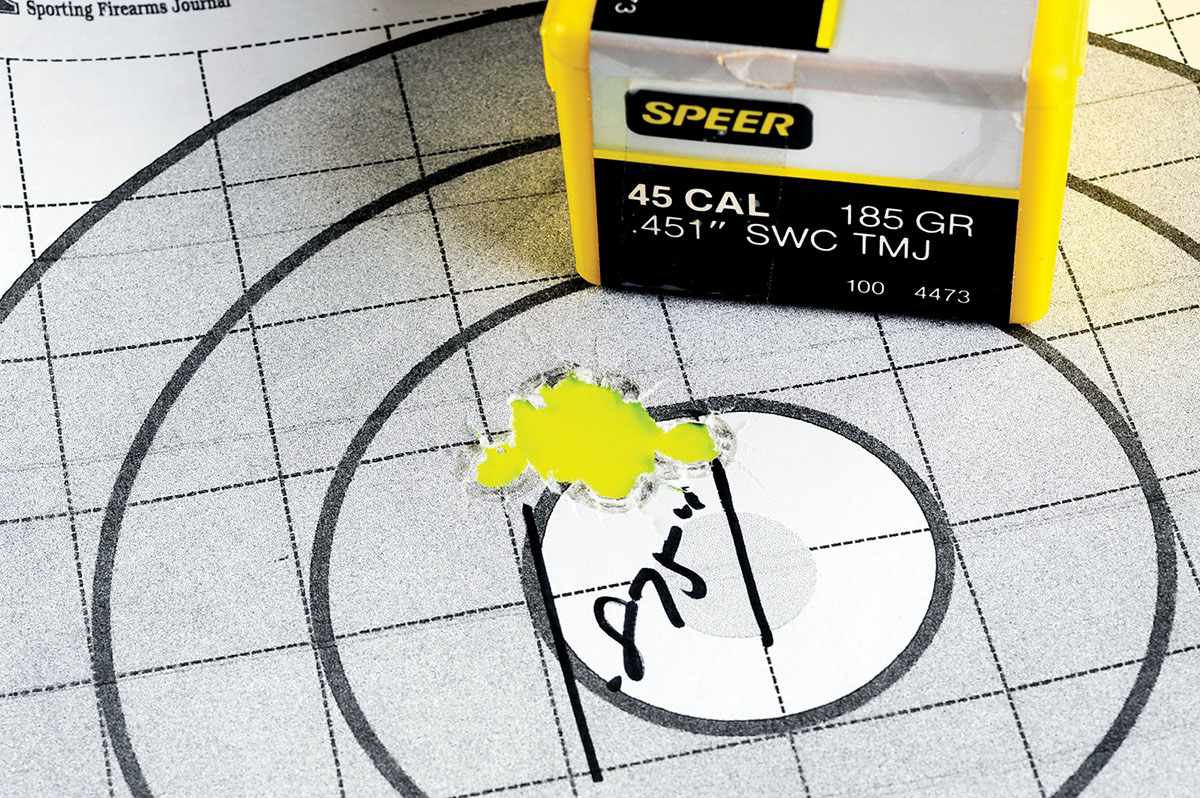
The second best group from my handloads was this .875-inch group with the Speer TMJ bullet over 9.5 grains of A-5.
By the numbers, whether new or once-fired, size all. The second die will flare or bell the case slightly to insert and seat the bullet without destroying the case. On the way down from the flare, priming is a good idea, then move over to powder charging, seating the bullet and finally, taper crimp all your rounds for flawless feeding.
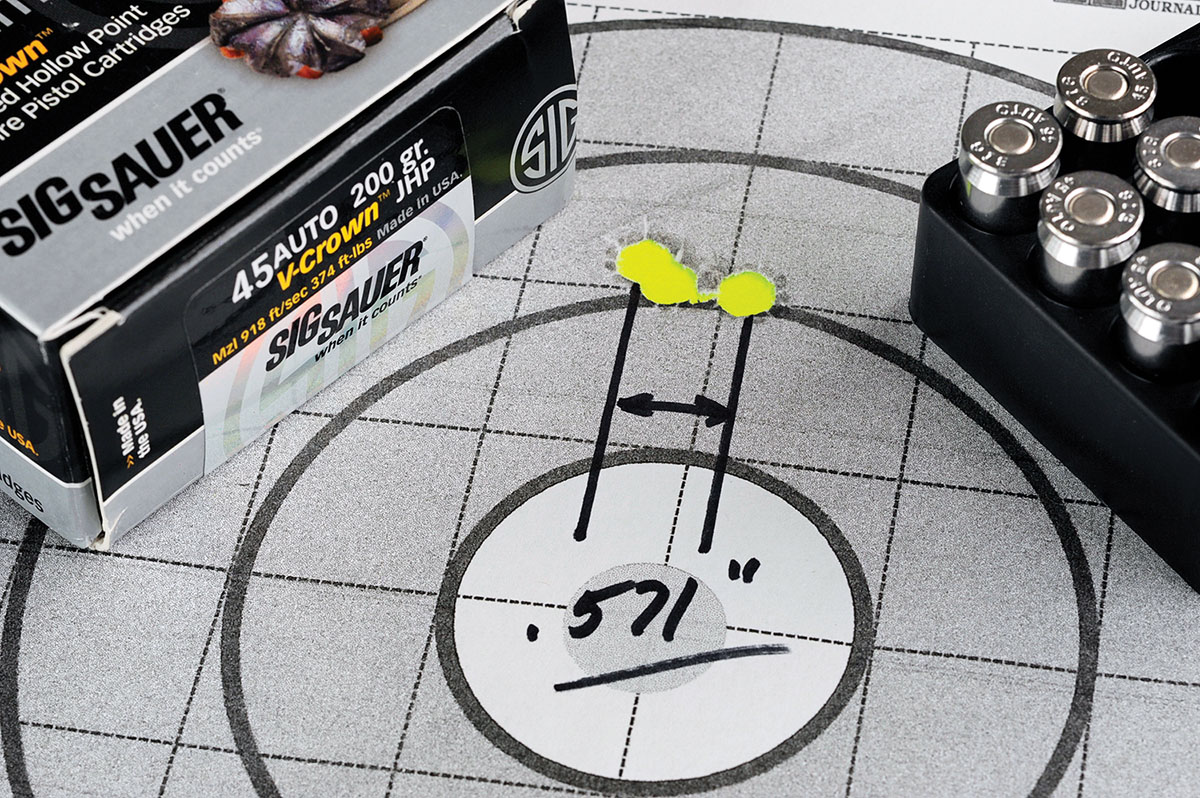
Here is a case for those who do not want to take the time to reload ammunition. With SIG Sauer factory ammunition, this group almost beat out the handloads with a .571-inch group.
On my session with the Savage/Ransom Rest combo, how did I do for the top three? Using five-shot groups as our standard, Hornady’s 200-grain Match C/T (combat/target) at 20 yards with 8.8 grains of Accurate No. 5, I hit .560 inch (about 9⁄16 of an inch) for a median velocity of 955 fps. Second place went to the Speer 185-grain TMJ bullet with 9.5 grains of Accurate No. 5 in the boiler room for 1,071 fps at .875 inch. Last, for “ball” ammunition, I picked Hornady’s 230-grain roundnose over 6 grains of Unique for an average of 815 fps. All were seated to 1.230 inches and again, taper crimped.
When it came to factory ammunition, the SIG Sauer Elite V-Crown jacketed hollowpoint came in at .570 inch, not much above our best handload! Interesting to note is that I registered 913 fps on my chronograph, while factory specifications came in at 918 fps.
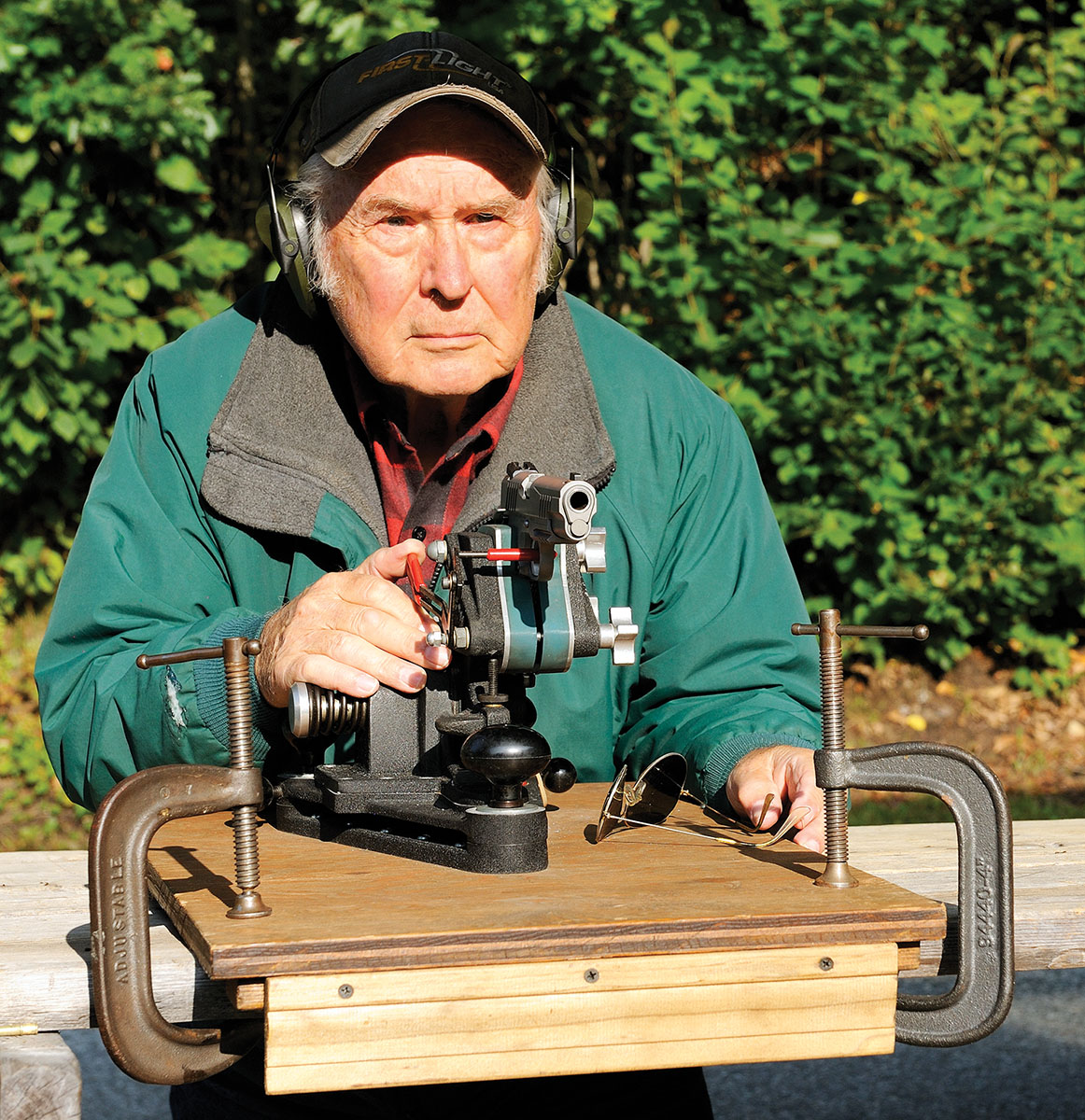
To test this gun without shooter input, Trzoniec mounted it in the Ransom Rest for accuracy testing.
Rounding up everything, the new Savage Model 1911 is one premium gun not demanding premium prices of two grand and above. Constructed with the best of everything, this Savage gun is finally finished, accurate and shooting the gun not only in the Ransom Rest but also offhand later proved it fully dependable no matter the ammunition I fed it.
In a few words, don’t pass this one by!
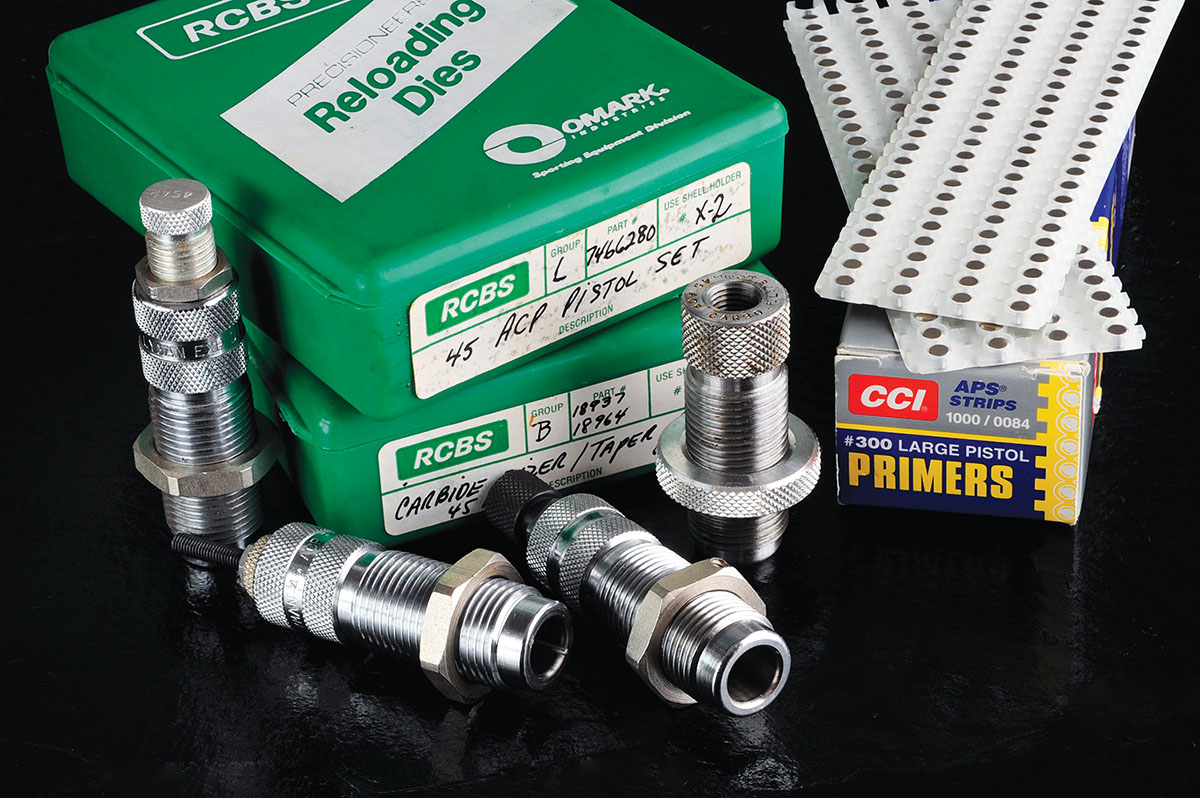
Reloading ammunition for the 45 ACP is easy thanks to up-to-date components available for serious shooters, and they last for years. This set of Lyman dies was purchased by Trzoniec more than four decades ago. An RCBS taper crimp die is to the right.













.jpg)
.jpg)


